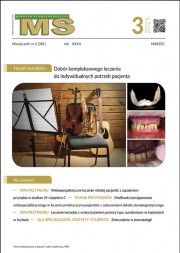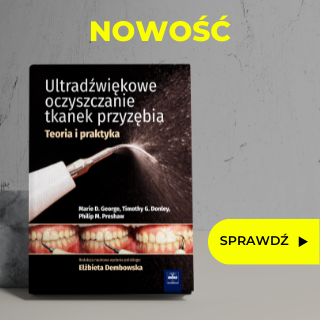Evaluation of functional disturbances in stomatognathic system in Down’s syndrome children treated at the Cracow Dental Clinic
Streszczenie
Wstęp. Jedną z cech zespołu Downa jest ogólne osłabienie mięśni, które w układzie stomatognatycznym manifestuje się wysuwaniem języka i nawykowym otwieraniem ust, co wpływa na mimikę twarzy, a także upośledza czynności ssania, żucia, połykania, oddychania i mowy.
Cel pracy. Celem pracy jest ocena wyników leczenia ortodontycznego 139 dzieci z Zespołem Downa.
Materiał i metody. Analizie poddano dzieci z trisomią 21 leczone w Krakowskiej Poradni Stomatologicznej w wieku od 1 miesiąca życia do 13 lat. Badaniem objęto 139 dzieci, 63 dziewczęta i 76 chłopców, o różnym stopniu upośledzenia umysłowego. Rehabilitacja była prowadzona średnio przez 30 miesięcy według opracowanego w poradni modelu. Oceniano czynność ssania, żucia, połykania oraz tor oddychania za pomocą opracowanej przez autorkę klinicznej skali punktowej.
Wyniki. Pod wpływem rehabilitacji ustno-twarzowej zmniejszyła się liczba dzieci z zaburzeniami badanych czynności, nie obserwowano zaburzeń o dużym stopniu nasilenia. Najlepsze efekty rehabilitacji obserwowano u niemowląt i dzieci do lat 3.
Wnioski. W wyniku rehabilitacji ustno-twarzowej stwierdzono istotną statystycznie poprawę czynności ssania, żucia, połykania oraz toru oddychania u dzieci z zespołem Downa.
Hasła indeksowe: zespół Downa, ssanie, żucie, połykanie
Summary
Introduction. One of the features of Down’s Syndrome is generalised muscular weakness that manifests itself in the stomatognathic system by protrusion of the tongue and habitual opening of the mouth which influences mimical facial movements and also impairs the functions of sucking, chewing, swallowing, breathing and speech. Aim of study. The aim of the study was to evaluate the results of orthodontic treatment of 139 children with Down’s syndrome.
Key words: Down’s syndrome, sucking, chewing, swallowing













